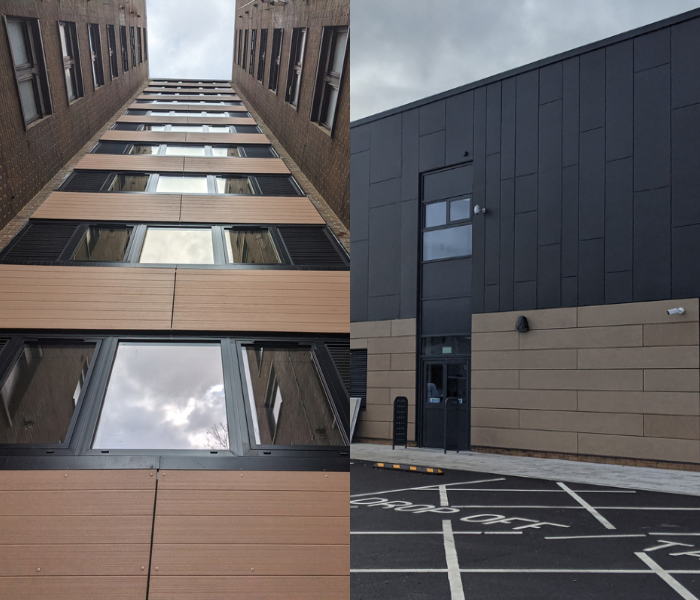Fibre cement: what is it and what are the pros and cons?
As facade and cladding experts, fibre cement is just one of many materials we work with when delivering projects for clients.
Several of our case studies mention this particular cladding material, but don’t explain exactly what fibre cement is. In this blog, we offer a quick introduction to fibre cement, and why it is often specified by clients for projects. This is one of many materials we have years’ experience installing and we’re not advocates of any one solution.
The basics: what is fibre cement?
The fibre cement market in the UK has been growing fast in recent years. Partly that is in line with a general growth in the construction sector. Also, though, fibre cement is widely regarded as an efficient and durable material.
Fibre cement is made by mixing cement paste with sand and also strands or fibres of reinforcing material. Originally, the fibres were asbestos. Historic fibre cement is therefore associated with health risk, but modern fibre cement never uses asbestos. The industry now uses cellulose, which is fibres taken from plants.
The fibres make cement tougher and long lasting. The material is mainly used in applications where relatively thin sheets of material need to be very strong. Mainly, that means cladding and roofing. It’s also used as a base for tiling in kitchens and bathrooms. Fibre cement is sold in thin sections described as sheets or boards. If you see reference to cement boards, it means fibre cement.
What are the advantages of fibre cement?
- Durability – fibre cement typically lasts half a century, and is very unaffected by rain, snow, heatwaves and harsh climates.
- Water resistant – not much water will get through this material, but in principle it’s porous and so is classed as water resistant rather than waterproof. It will be unaffected by damp, condensation and other water, and can be made waterproof by applying liquid sealant or adding waterproofing membranes.
- Low maintenance – this resistant material will sit there for decades, typically requiring very little maintenance. It won’t rot, and its toughness means it won’t be troubled by pest species. It is also very easy to clean.
What are the limitations of fibre cement?
Fibre cement is a specialist material, and can be more difficult to work with than other rainscreen cladding options. Its very toughness means specialist equipment is needed to cut it, which creates silica dust, a substance associated with detailed health and safety regulation. As well as providing respirators, site managers must test regularly for levels of silica dust, and control those levels using vacuum tools or water as an absorbent.
Unlike wood or metal, fibre cement is brittle. When it comes to installation, it’s essential to work with an experienced team. Fibre cement boards can be installed t quickly by a team who know what they’re doing, but less experienced installers could find that installed incorrectly, fibre cement can crack when weight is applied.
What other factors should be considered?
- Cost efficiency – the purchase and installation of fibre cement can cost more up front than other materials. However, the durability of the material can make it very competitive in the long run.
- Environmental benefits – the sustainability implications of this material can be debated. Key ingredient Portland cement has a high carbon footprint, but as fibre cement is very long lasting and requires little maintenance, the lifecycle carbon footprint is likely to be low. Importantly, it is also easy to recycle.
- Insulation advantages – In general, fibre cement is considered a good insulator, though other cladding systems can claim that also. It’s crucial to emphasise that good cladding of some form is vital to the improved energy performance of your building.
Fibre cement case studies
- West Kensington Estate – like the above project, this involved using Valcan’s fibre cement product Ceramapanel
Alternatives to fibre cement
If you would like to find out more about any of our services, please don’t hesitate to get in touch:

